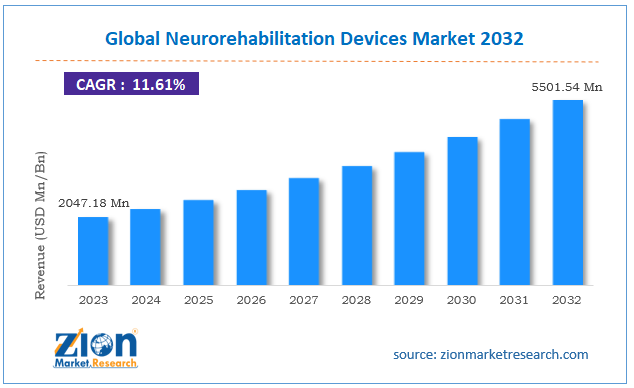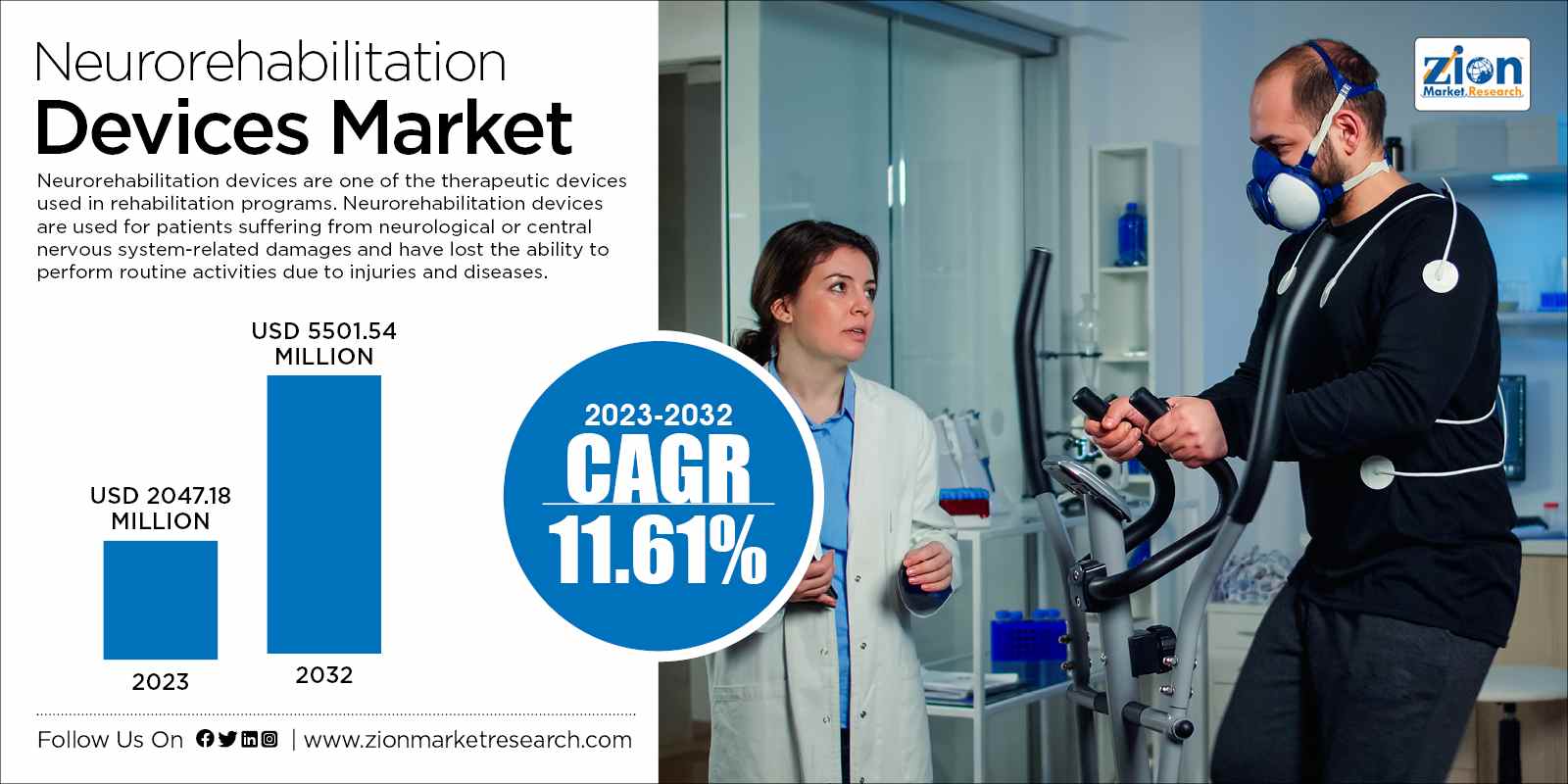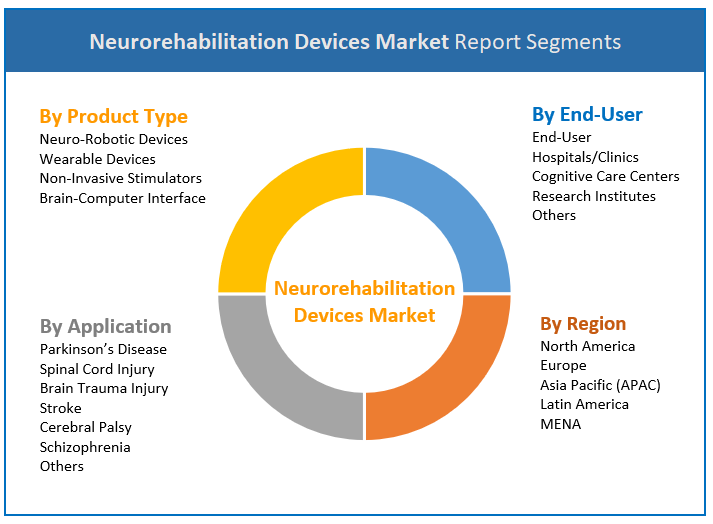Neurorehabilitation Devices Market Size, Trends, Growth, Analysis Report 2032

Neurorehabilitation Devices Market by Product Type (Neuro-Robotic Devices, Non-Invasive Stimulators, Wearable Devices, and Brain-Computer Interface), by Application (Parkinson’s Disease, Brain Trauma Injury, Spinal Cord Injury, Stroke, Schizophrenia, Cerebral Palsy, and Others), and by End-User (Hospitals/Clinics, Cognitive Care Centers, Research Institutes, and Others): Global Industry Perspective, Comprehensive Analysis, and Forecast, 2024 - 2032
| Market Size in 2023 | Market Forecast in 2032 | CAGR (in %) | Base Year |
|---|---|---|---|
| USD 2047.18 Million | USD 5501.54 Million | 11.61% | 2023 |
Neurorehabilitation Devices Industry Prospective:
The global neurorehabilitation devices market size was worth around USD 2047.18 million in 2023 and is predicted to grow to around USD 5501.54 million by 2032 with a compound annual growth rate (CAGR) of roughly 11.61% between 2024 and 2032.
The report covers forecasts and analyses for the neurorehabilitation devices market on a global and regional level. The study provides historical data for 2018 to 2022 along with a forecast from 2024 to 2032 based on revenue (USD Million). The study includes drivers and restraints for the Neurorehabilitation devices market along with the impact they have on the demand over the forecast period. Additionally, the report includes the study of opportunities available in the neurorehabilitation devices market on a global level.
In order to give the users of this report a comprehensive view of the neurorehabilitation devices market, we have included a competitive landscape and analysis of Porter’s Five Forces model for the market. The study encompasses a market attractiveness analysis, where the product, mode of purchase, application, end-user, and regional segmentation are benchmarked based on their market size, growth rate, and general attractiveness.
The report provides a company market share analysis in order to give a broader overview of the key players in the market. In addition, the report also covers key strategic developments of the market including acquisitions & mergers, new product launches, agreements, partnerships, collaborations & joint ventures, research & development, and regional expansion of major participants involved in the market on a global and regional basis.
Neurorehabilitation, also known as neurological rehabilitation, is a doctor-supervised program aimed at people suffering from injuries or disorders related to the nervous system. Neurorehabilitation helps to create a new way of living so that the patients are able to live and work as normally as possible. An injury of the central nervous the system or the brain can significantly affect a person’s ability to perform a variety of daily tasks or activities. Neurorehabilitation helps to improve the patients’ ability to function independently after they are diagnosed with stroke, multiple sclerosis, brain tumor, Parkinson’s disease, epilepsy, and traumatic brain injuries, among other neurological disorders. The focus of neurorehabilitation devices is to improve the functioning of the nervous system or to look for new ways to achieve normal functioning. Physiotherapists help patients in coping up with the physical, behavioral, and cognitive issues.
The global neurorehabilitation devices market is gaining popularity due to the increasing worldwide occurrences of neurological disorders. Additionally, a substantial rise in neurological diseases, growing neurorehabilitation wearables and robotics, and technological advancements made in the field of neurorehabilitation devices are projected to boost the global neurorehabilitation devices market in the upcoming years. According to the Parkinson’s Foundation, nearly 1 million people will be living with Parkinson's disease in the U.S. by 2020. Nearly 60,000 people in the U.S. are diagnosed with Parkinson's disease every year and there are more than 10 million people living with Parkinson's disease worldwide. According to the Centers for Disease Control and Prevention (CDC), in the U.S., 7.4 million people suffer from a stroke.
In the U.S., stroke kills about 140,000 every year and approximately 7, 95,000 people have a stroke. Stroke is one of the leading causes of serious chronic disability. Increasing occurrences and incidence rates of neurological disorders create a huge demand for neurorehabilitation devices. This is due to the fact that neurorehabilitation devices ensure simplification of routine tasks for disabled patients by reducing their dependency on others. Furthermore, the geriatric population is likely to drive the neurorehabilitation devices market in the upcoming years.
However, high costs of the neurorehabilitation devices might hamper the neurorehabilitation devices market growth. Additionally, the absence of personalized home care neurorehabilitation devices, inadequate disposable income in developing economies, and unavailability of skilled specialists to handle these devices might also hinder the market growth. But growing geriatric population and increasing neurological diseases are likely to offer opportunities for neurorehabilitation devices market in the future.
Neurorehabilitation Devices Market Segments Analysis
The neurorehabilitation study provides a decisive view of the neurorehabilitation devices market by segmenting the market based on product type, application, end-user, and region. All the segments have been analyzed based on present and future trends and the market is estimated from 2024 to 2032.
Based on product type, the neurorehabilitation devices market is segmented into neuro-robotic devices, wearable devices, non-invasive stimulators, and brain-computer interfaces.
Based on application, the neurorehabilitation devices market has been segmented into Parkinson’s disease, spinal cord injury, brain trauma injury, stroke, cerebral palsy, schizophrenia, and others. The neuro-robotics segment held the largest share of the global neurorehabilitation devices market in 2022, due to the advancements made in robotics technology and its combination with neuroscience leading to the emergence of next-generation rehabilitation techniques. The stroke segment held a major market share in 2022, due to the increasing frequency of stroke globally.
Based on end-users, the neurorehabilitation devices market is segmented into hospitals/clinics, cognitive care centers, research institutes, and others.
The growing prevalence of neurological disorders increased elderly population, and technological breakthroughs in neurorehabilitation devices are the major driving factors of the neurorehabilitation devices market. The lack of ease associated with the usage of these devices, the shortage of personalized home care neurorehabilitation devices, and insufficient disposable income witnessed across the developing countries might hinder the market growth during the forecast period.
Neurorehabilitation Devices Market: Report Scope
| Report Attributes | Report Details |
|---|---|
| Report Name | Neurorehabilitation Devices Market |
| Market Size in 2023 | USD 2047.18 Million |
| Market Forecast in 2032 | USD 5501.54 Million |
| Growth Rate | CAGR of 11.61% |
| Number of Pages | 220 |
| Key Companies Covered | Bionik Labs, Bioxtreme, Denecor, Ectron Ltd., Ekso Bionics, Helius Medical Technologies, Hocoma AG, MagVenture A/S, Medtronic, Neuro Style, Rehab-Robotics Company Limited, Rehabtronics Inc., St. Jude Medical Inc., Tyromotion, and others. |
| Segments Covered | By Product Type, By Application, By End-User, and By Region |
| Regions Covered | North America, Europe, Asia Pacific (APAC), Latin America, The Middle East and Africa (MEA) |
| Base Year | 2023 |
| Historical Year | 2018 to 2022 |
| Forecast Year | 2024 - 2032 |
| Customization Scope | Avail customized purchase options to meet your exact research needs. Request For Customization |
The regional segmentation includes the current and forecasted demand in North America, Europe, Asia Pacific, Latin America, and the Middle East and Africa with it further segmented into major countries including the U.S., Germany, Italy, France, UK, China, Japan, India, and Brazil. This segmentation includes demand for the fertility test market based on individual segments and applications in all regions and countries.
By geography, North America, Europe, Asia Pacific, the Middle East, and Africa, and Latin America are the major regions in the global neurorehabilitation devices market. North America is projected to lead the global neurorehabilitation devices market due to the rising geriatric population, growing incidences of Alzheimer’s and Parkinson’s disease, funding made by the federal governments, and initiatives taken by the Senate of Canada are the key factors contributing to this regional market. Europe is another major dominant player in the neurorehabilitation devices market, which is mainly driven by the prevalence of neurological disorders, advancements made in technology, availability of developed infrastructure, and increasing awareness about the advantages and effectiveness of neurorehabilitation devices and centers.
The Asia Pacific is the fastest growing market for neurorehabilitation devices during the forecast period. The key factor driving the growth of this regional market includes awareness among people related to neurological disorders. Neurorehabilitation is on the rise in this region leading to increased adoption of neurorehabilitation devices. Additionally, developing countries, such as China and India, are expected to offer significant growth opportunities to the market players. Due to the lack of comfort associated with the usage of neurorehabilitation device and its unaffordability in the Middle East and Africa and Latin America, neurorehabilitation devices market growth is slow.
Some key players of the neurorehabilitation devices market are Hocoma AG, Medtronic, Bionik Labs, St. Jude Medical Inc., Denecor, Bioxtreme, Ectron Ltd., MagVenture A/S, Helius Medical Technologies, Ekso Bionics, Rehabtronics Inc., Rehab-Robotics Company Limited, Neuro Style, and Tyromotion, among others.
Neurorehabilitation Devices Market: Competitive Analysis
The global neurorehabilitation devices market is led by players like:
- Bionik Labs
- Bioxtreme
- Denecor
- Ectron Ltd.
- Ekso Bionics
- Helius Medical Technologies
- Hocoma AG
- MagVenture A/S
- Medtronic
- Neuro Style
- Rehab-Robotics Company Limited
- Rehabtronics Inc.
- St. Jude Medical Inc.
- Tyromotion
This report segments the global neurorehabilitation devices market as follows:
Global Neurorehabilitation Devices Market: By Product Type
- Neuro-Robotic Devices
- Wearable Devices
- Non-Invasive Stimulators
- Brain-Computer Interface
Global Neurorehabilitation Devices Market: By Application
- Parkinson’s Disease
- Spinal Cord Injury
- Brain Trauma Injury
- Stroke
- Cerebral Palsy
- Schizophrenia
- Others
Global Neurorehabilitation Devices Market: By End-User
- Hospitals/Clinics
- Cognitive Care Centers
- Research Institutes
- Others
Global Neurorehabilitation Devices Market: By Region
- North America
- The U.S.
- Europe
- UK
- France
- Germany
- Asia Pacific
- China
- Japan
- India
- Latin America
- Brazil
- The Middle East and Africa
Table Of Content
Methodology
FrequentlyAsked Questions
Neurorehabilitation devices are one of the therapeutic devices used in rehabilitation programs. Neurorehabilitation devices are used for patients suffering from neurological or central nervous system-related damages and have lost the ability to perform routine activities due to injuries and diseases.
According to a study, the global neurorehabilitation devices market size was worth around USD 2047.18 million in 2023 and is predicted to grow to around USD 5501.54 million by 2032.
The CAGR value of the neurorehabilitation devices market is expected to be around 11.61% during 2024-2032.
North America is expected to dominate the neurorehabilitation devices market over the forecast period.
The global neurorehabilitation devices market is dominated by players like Bionik Labs, Bioxtreme, Denecor, Ectron Ltd., Ekso Bionics, Helius Medical Technologies, Hocoma AG, MagVenture A/S, Medtronic, Neuro Style, Rehab-Robotics Company Limited, Rehabtronics Inc., St. Jude Medical Inc., and Tyromotion, among others.
The neurorehabilitation devices market report covers the geographical market along with a comprehensive competitive landscape analysis. It also includes cash flow analysis, profit ratio analysis, market basket analysis, market attractiveness analysis, sentiment analysis, PESTLE analysis, trend analysis, SWOT analysis, trade area analysis, demand & supply analysis, Porter’s five forces analysis, and value chain analysis.
Choose License Type
RelatedNews
HappyClients
Zion Market Research
Tel: +1 (302) 444-0166
USA/Canada Toll Free No.+1 (855) 465-4651
3rd Floor,
Mrunal Paradise, Opp Maharaja Hotel,
Pimple Gurav, Pune 411061,
Maharashtra, India
Phone No +91 7768 006 007, +91 7768 006 008
US OFFICE NO +1 (302) 444-0166
US/CAN TOLL FREE +1 (855) 465-4651
Email: sales@zionmarketresearch.com
We have secured system to process your transaction.
Our support available to help you 24 hours a day, five days a week.
Monday - Friday: 9AM - 6PM
Saturday - Sunday: Closed








